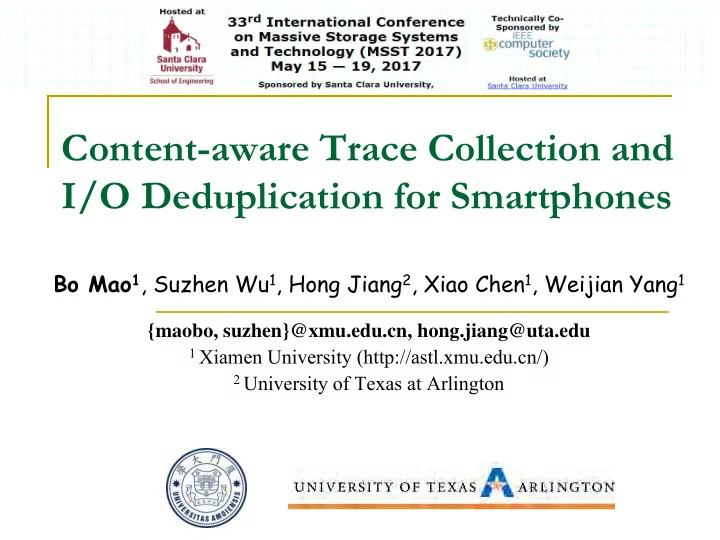

Content-aware Trace Collection and I/O Deduplication for Smartphones Bo Mao 1 , Suzhen Wu 1 , Hong Jiang 2 , Xiao Chen 1 , Weijian Yang 1 {maobo, suzhen}@xmu.edu.cn, hong.jiang@uta.edu 1 Xiamen University (http://astl.xmu.edu.cn/) 2 University of Texas at Arlington
Outline Introduction and challenges Trace collection and observations System overview and design Performance evaluations Conclusion
Why data deduplication? Backup media changed from Tape to HDDs Capacity Cost In primary storage systems, it is also important to shrink the data volume.
Data deduplication Data deduplication is widely deployed in secondary storage systems to: Reduce backup time Improve storage space efficiency Improve network bandwidth …… In primary storage systems: VM-based storage systems (Linux KSM) Flash storage products (Nimble storage, Tintri, Pure Storage …) ……
Deduplication + Flash CA-FTL (FAST’11) CA-SSD (FAST’11) Deduplication has become an important feature for flash-based storage!
Flash within Smartphones Flash (eMMC or UFS) in Smartphones: Performance tends to degrade after repeated usages. Limited life cycles affect the Smartphones’ reliability. The cost of upgrading flash capacity is high. How about applying data deduplication on flash storage within Smartphones?
Workflow of data deduplication Fixed chunk, CDC, FastCDC… Write data StoreGPU, Shredder … DDFS, ChunkStash, SiLo … CPU and Memory Overhead! Devices
Challenges Resources in Smartphones: CPU utilizations affect power consumption. Limited memory capacity. Mobile APP usages. Is data deduplication feasible and how to? How to investigate the redundancy within Smartphones? How much data redundancy in mobile APPs? How to design a lightweight data deduplication engine?
Content-aware trace collection
Obs 1: Redundancy characteristics * Moderate to high data redundancy exists within mobile APPs. Amount of data redundancy shared between any two different mobile APPs is minimal # . *Detailed results and analysis for all the 15 mobile APPs can be found in our paper. # Y. Fu, H. Jiang, N. Xiao, L. Tian, F. Liu, AA-Dedupe: An Application-Aware Source Deduplication Approach for Cloud Backup Services in the Personal Computing Environment, in Proceedings of IEEE Cluster 2011, Austin, Texas, Sept. 2011.
Obs 2: Lower IOPS The I/O intensity is low for most APPs (IOPS)* *D. Zhou, W. Pan, W. Wang, and T. Xie, I/O Characteristics of Smartphone Applications and Their Implications for eMMC Design, in Proceedings of IISWC 2015, Atlanta,, USA, Oct. 2015.
System overview Independent of upper file systems Low overhead design choice: MD5 hash computing Fixed chunking (4KB) Two optimizations: Index partition Chunk store
Design and Optimizations APP-aware Index Partition (AIP): Memory overhead associated with big hash index table . Grouping the hash index according to the APPs. Swap In/Out between memory and Flash. APP-aware Chunk Store (ACS): Data fragmentation associated with data deduplication . Storing the data chunks according to the APPs (LBAs). Concentrating the read accesses to a single container.
Write workflow in APP-Dedupe
Experimental setup Google Nexus 5 Smartphone: Real system study . Qualcomm MSM8974 Quadcore 2.3 GHz, 2 GByte DRAM, 16 GByte eMMC storage. Android 5.0.1 with Linux Kernel 3.4. Benchmarks: Monkey tool and A1 SD Bench. SSD-based DiskSim simulator: Simulation study . Replay the traces collected from real system. Evaluate response time and GC count within flash.
Results and analysis (1) Memory and CPU usages (2) Total written data (3) Throughput APP-Dedupe incurs very little memory and CPU overhead, by less than 3%. APP-Dedupe reduces the amount of write data to the back- end eMMC storage by an average of 45.2%. System throughput performance is complicated.
Results and analysis By up to 15.4% with an average of 6.2% By up to 58.7% with an average of 41.5%
Conclusion Performance of the storage subsystem in Smartphones plays an important role in the application performance. We investigate the data redundancy characteristics within Smartphones and propose APP-Dedupe that detects and eliminates the I/O redundancy by exploiting the mobile applications’ redundancy characteristics. APP-Dedupe reduces the GC overhead by an average of 41.5%, reduces the response times by up to 15.4% and saves the storage capacity by an average of 45.2%.
Content-aware Trace Collection and I/O Deduplication for Smartphones Bo Mao 1 * , Suzhen Wu 1 , Hong Jiang 2 , Xiao Chen 1 , Weijian Yang 1 1 Xiamen University (http://astl.xmu.edu.cn/) 2 University of Texas at Arlington * Please feel free to contact me: maobo@xmu.edu.cn for any questions!
Recommend
More recommend